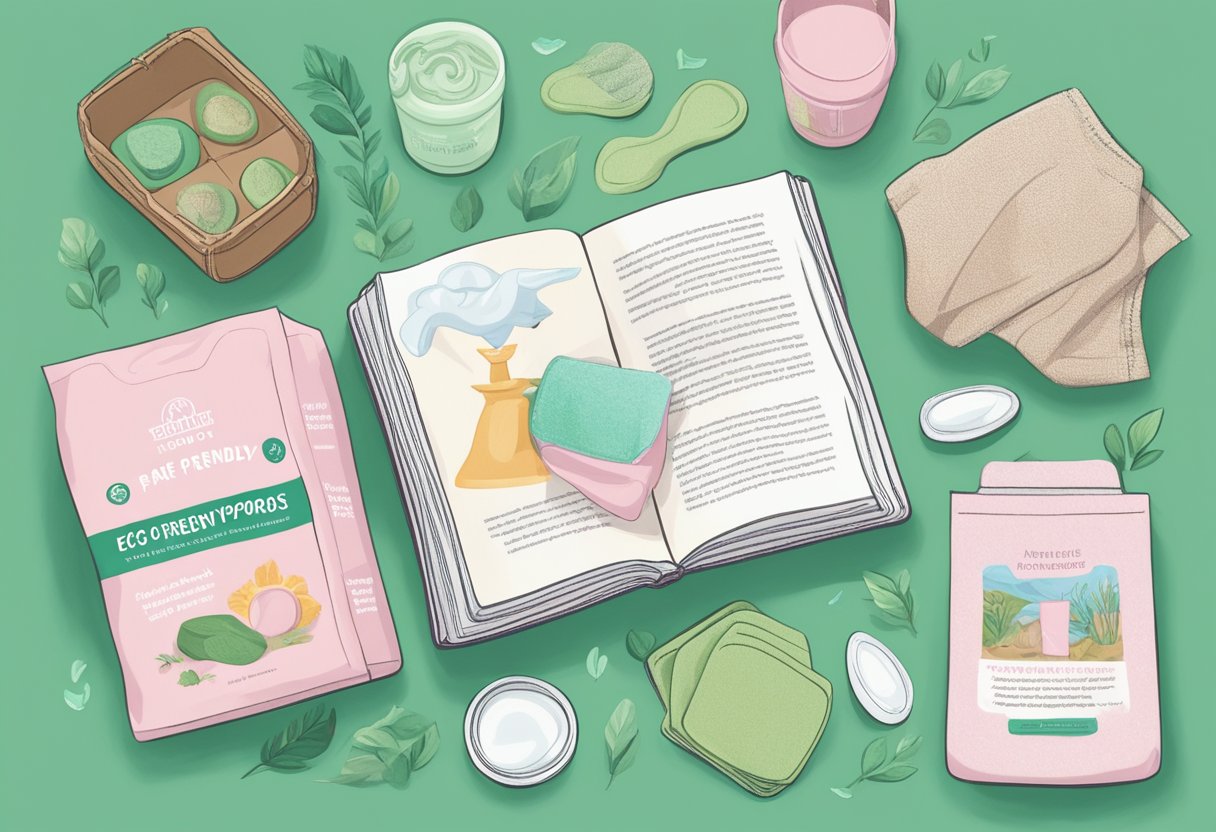The journey through perimenopause to menopause marks a significant stage in a woman’s life that brings various changes, both physically and emotionally.
Managing symptoms effectively is crucial, yet many may not consider the environmental impact of the products they use.
An increasing number of women are seeking eco-friendly alternatives that align with a sustainable lifestyle, mindful of the planet while taking care of their bodies.

In the transition to menopause, women typically rely on an assortment of products, ranging from sanitary items to remedies that ease symptoms like hot flashes and mood swings.
Traditional products often contain plastics and chemicals that can harm the environment.
Fortunately, there are sustainable options available, including organic cotton pads, biodegradable tampons, and reusable silicone menstrual cups, which can drastically reduce the ecological footprint.
Understanding the array of eco-friendly products and their benefits is key for women during these stages of life.
These products not only support environmental well-being but also offer health advantages, such as reduced exposure to synthetic materials and chemicals.
Transitioning to these sustainable alternatives helps maintain personal hygiene and comfort during perimenopause and menopause, without compromising the health of the planet.
Understanding Menopause

Menopause is a natural biological process in a woman’s life, marking the end of her menstrual cycles. The transition is accompanied by various symptoms and has distinct stages.
Stages of Menopausal Transition
- Perimenopause: This stage begins several years before menopause, when the ovaries gradually produce less estrogen. It usually starts in a woman’s 40s but can start in the 30s as well.
- Menopause: This occurs when a woman hasn’t menstruated in 12 consecutive months. At this point, the ovaries have stopped releasing eggs and producing most of their estrogen.
- Postmenopause: These are the years after menopause. During this stage, menopausal symptoms ease for most women, but health risks related to the loss of estrogen increase.
Common Symptoms and Management
Symptoms:
- Hot flashes
- Night sweats
- Mood changes
- Sleep problems
- Weight gain and slowed metabolism
- Thinning hair and dry skin
- Vaginal dryness
Management:
- Lifestyle Changes: regular exercise, a healthy diet, and weight management can alleviate symptoms.
- Medication: Hormone replacement therapy (HRT) may provide relief but should be discussed with a healthcare provider.
- Alternative Therapies:
- Acupuncture
- Yoga
- Meditation
Eco-Friendly Menstrual Products

Eco-friendly menstrual products are essential for reducing environmental impact. They offer sustainable alternatives to traditional disposable items.
Organic Cotton Options
Organic cotton products provide a natural choice for menstrual care. They don’t contain pesticides or chemicals often found in conventional cotton.
- Pads: Made from organic cotton, these pads decompose more easily than synthetic alternatives.
- Tampons: Options without applicators reduce plastic waste, and organic cotton ensures a lower environmental footprint.
Reusable Menstrual Cups
Menstrual cups crafted from medical-grade silicone represent a long-lasting solution.
- Durability: They can last for several years, significantly cutting down on waste.
- Health: Silicone is hypoallergenic, offering a safe option devoid of toxins sometimes present in disposable items.
Biodegradable Pads
Biodegradable pads offer a compromise between the convenience of disposables and environmental mindfulness.
- Materials: These pads often use organic cotton, bamboo fibers, and other compostable materials.
- Packaging: Many brands prioritize recyclable or biodegradable packaging to further lessen waste.
Lifestyle Changes for a Greener Transition

Making sustainable lifestyle changes can significantly ease the transition through perimenopause and menopause while benefiting the environment.
These changes focus on diet, exercise, stress management, and natural remedies.
Diet and Exercise
To support a greener transition, women may consider incorporating organic, plant-based foods into their diets, which can help balance hormones and reduce symptoms.
Foods like soy, flaxseeds, and leafy greens are rich in phytoestrogens and essential nutrients.
Regular exercise, such as yoga or walking, helps maintain a healthy weight and reduces the risk of menopausal weight gain.
These actions not only improve one’s health but also have a lower environmental impact due to the reduced reliance on processed foods and meat production.
- Recommended Foods:
- Soy products
- Flaxseeds
- Leafy greens
- Fruits and vegetables (preferably organic)
- Exercise Suggestions:
- Yoga
- Brisk walking
- Swimming
- Cycling
Stress Reduction Techniques
Stress can exacerbate menopause symptoms, so implementing stress reduction techniques is both healthy for the individual and eco-friendly.
Practices such as mindfulness meditation, deep breathing exercises, and spending time in nature are beneficial for mental health and have minimal environmental impact.
- Stress-Reduction Techniques:
- Mindfulness meditation
- Deep breathing exercises
- Nature walks
Natural Remedies
Women may opt for natural remedies to manage menopause symptoms.
Using reusable or sustainably sourced products like natural, cooling gel pads for hot flashes or organic cotton sleepwear can provide comfort without the waste of single-use products.
Herbs such as black cohosh and evening primrose oil are also used for symptom relief and are more environmentally friendly when sourced sustainably.
- Eco-Friendly Remedies:
- Cooling gel pads (reusable)
- Organic cotton sleepwear
- Black cohosh
- Evening primrose oil
Environmental Impact of Menstrual Products

Menstrual products such as pads and tampons contribute significantly to environmental waste. Sustainable alternatives are increasingly available to mitigate this impact.
Traditional Products vs. Sustainable Alternatives
Traditional Menstrual Products
- Materials: Often made from a blend of cotton and synthetic materials like rayon.
- Lifespan: Single-use with an estimated decomposition time of 500 to 800 years in landfills.
- Chemical Exposure: May contain dioxins, fragrances, and adhesives that can pose environmental hazards.
Sustainable Menstrual Products
- Materials: Include organic cotton, bamboo, and medical-grade silicone.
- Lifespan: Reusable products like silicone menstrual cups can last up to 10 years.
- Environmental Benefits: Significantly reduce waste and exposure to harmful chemicals.
Waste Reduction Strategies
Reusable Products: Menstrual cups, cloth pads, and period underwear can be washed and reused for several years, decreasing the amount of menstrual waste.
Biodegradable Options: Biodegradable pads and tampons made from organic cotton decompose much more quickly than conventional products.
Packaging: Choosing products with minimal or recyclable packaging helps reduce plastic waste.
Advocacy and Education

In the push for eco-friendly transitions from periods to menopause, advocacy and education play pivotal roles. They ensure widespread understanding and adoption of sustainable practices.
Community Involvement
Community involvement is crucial in driving the adoption of sustainable menstrual and menopause products.
Local organizations can host workshops and discussion groups, offering individuals the opportunity to learn about eco-friendly options such as reusable pads or hormone-free symptom management techniques.
By involving local health clinics, they can also ensure these products are accessible and provide instructions for their use.
- Workshops on sustainable living during menopause
- Discussion groups for sharing experiences and solutions
Public Awareness Campaigns
Public awareness campaigns are essential for shifting perceptions and driving change on a larger scale.
They can utilize various platforms such as social media, local radio, and community bulletin boards to spread knowledge about the environmental impact of traditional menstrual products and the benefits of eco-friendly alternatives.
- Social Media Hashtags: #EcoMenopause #SustainablePeriods
- Informational Flyers: Guides on where to buy organic cotton products, instructions for using silicone menstrual cups, and tips for reducing waste during menopause

